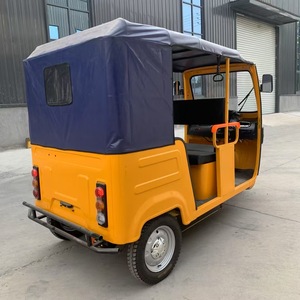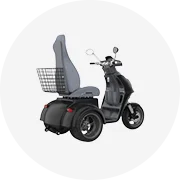Types of Enclosed Adult Tricycles
There are two primary types of enclosed adult tricycles, also known as recumbent tricycles. Each offers distinct advantages for different riding styles and preferences:
Electric Pedal-Assist Tricycles
The enclosed adult pedal-assist tricycle features an intelligent electric motor that senses the rider's pedaling effort and provides proportional assistance. This creates a natural, intuitive riding experience.
- Smart Assistance: Motor matches rider's pedaling effort
- Control Panel: Handlebar-mounted for easy adjustment
- Gearing System: Typically 3-speed, with premium models offering more options
- Special Tires: Enhanced rolling resistance for better grip
- Battery: Rechargeable power source with various range options
Best For: Exercise enthusiasts and daily commuters seeking a balance of physical activity and motorized assistance
Standard Electric Tricycles
Standard electric enclosed adult tricycles provide constant power regardless of pedaling intensity. This makes them perfect for riders who prefer consistent assistance without variable effort.
- Assistance Levels: Low, medium, and high settings
- Control Interface: User-friendly handlebar panel
- Battery Range: 30-70 miles depending on assistance level
- Power Delivery: Continuous motor assistance without pedaling requirement
- Comfort Focus: Designed for relaxed, leisurely riding
Best For: Leisure riders and those navigating hilly terrain who want consistent power without variable effort
Specifications of Enclosed Adult Tricycles
Understanding the key specifications of enclosed adult tricycles helps riders select the perfect model for their needs. Each component contributes to the overall performance, comfort, and suitability for specific riding conditions.
| Component | Options | Performance Impact |
|---|---|---|
| Frame | Aluminum or Steel | Aluminum offers lightweight design; steel provides superior strength |
| Wheel Size | 16-26 inches diameter | Larger wheels improve speed and smoothness; smaller wheels enhance agility |
| Transmission | 7-speed hub gear or 18-speed derailleur | Hub gear for low maintenance on flat terrain; derailleur for versatile hill climbing |
| Brakes | Disc brakes or V-brakes | Disc brakes excel in wet conditions; V-brakes offer lightweight, economical option |
| Suspension | With or without suspension system | Suspension improves comfort on rough terrain; no suspension reduces weight |
| Tires | Puncture-resistant, various widths, reflective options | Wider tires provide stability; reflective strips enhance visibility |
| Handlebar | Trekking, drop, or straight bar styles | Different styles offer varied riding positions and comfort levels |
| Seat | Padded, with/without backrest, adjustable height | Backrests provide additional support; adjustable height accommodates riders |
Maintenance of Enclosed Adult Tricycles
Proper maintenance ensures the longevity, safety, and optimal performance of your enclosed adult tricycle. Following manufacturer guidelines is essential, but these general maintenance practices apply to most models:
Essential Maintenance Schedule
| Maintenance Area | Frequency | Key Tasks |
|---|---|---|
| Chain & Gears | Bi-weekly | Clean with brush/cloth, apply lubricant evenly, check gear shifting |
| Tires | Weekly | Check pressure, inspect wear/damage, evaluate tread depth |
| Brakes | Monthly | Inspect pads for wear, adjust as needed, clean discs/rims |
| Suspension | Quarterly | Check for smooth operation, clean components, lubricate per guidelines |
| Frame | Monthly | Inspect for cracks/damage, clean thoroughly, check connections |
| Electrical System | Monthly | Check battery connections, maintain proper charging cycles, inspect wiring |
Regular maintenance prevents costly repairs, ensures rider safety, and maintains the tricycle's performance. For electrical components, consult the manufacturer's specific guidelines to maintain warranty coverage and optimal function.
How to Choose Enclosed Adult Tricycles
Selecting the right enclosed adult tricycle involves careful consideration of several factors to ensure it meets your specific needs and preferences. This comprehensive selection guide highlights the key factors to evaluate:
DIY Maintenance and Replacement Guide
With basic mechanical knowledge and the right tools, many maintenance and repair tasks on enclosed adult tricycles can be performed at home. This DIY approach can save money and give you greater control over your tricycle's performance.
Essential DIY Toolkit
These tools form the foundation of your tricycle maintenance kit:
Basic Repair and Replacement Process
- Thorough Cleaning: Wash and clean the tricycle thoroughly before any repair work. This removes dirt and grime that could interfere with components or hide damage.
- Careful Disassembly: Use the appropriate tools to remove the damaged component. Take photos or notes during disassembly to aid reassembly.
- Compatibility Verification: Ensure replacement parts match the specifications of your tricycle model. Bring the old part for comparison when purchasing replacements.
- Proper Assembly: Follow the user manual and reference materials to correctly install new components. Apply appropriate lubricants where needed.
- Comprehensive Testing: Before regular use, test all repaired systems to ensure proper function and safety. Begin with low-stress tests before full riding.
Pro Tip: Keep a maintenance log recording all repairs, replacements, and routine maintenance. This history helps identify recurring issues and maintain optimal performance.
Frequently Asked Questions
Yes, riding enclosed adult tricycles offers numerous health benefits:
- Cardiovascular improvement: Regular riding promotes heart health by increasing heart rate and improving circulation
- Muscle strengthening: Particularly benefits leg muscles, core, and lower body
- Joint-friendly exercise: Low-impact activity that's easier on knees and ankles than running
- Balance and coordination: Improves proprioception and body awareness
- Mental wellbeing: Outdoor activity can reduce stress and improve mood
Absolutely! Enclosed adult tricycles are highly customizable for specialized requirements:
- Accessibility modifications: Adjustable seats, wheelchair integration, and adaptive controls
- Technology integration: GPS navigation, performance monitors, and electronic shifting systems
- Cargo customization: Custom racks, baskets, and storage solutions
- Comfort enhancements: Specialized seating, suspension upgrades, and ergonomic handlebars
- Assistive technologies: Voice-activated controls, simplified interfaces for users with cognitive impairments
Weight capacity varies by model, but most enclosed adult tricycles are designed with robust weight tolerances:
- Standard capacity range: 250-400 pounds (113-181 kg)
- Heavy-duty models: Some specialized models can support up to 500 pounds (227 kg)
- Capacity considerations: Weight limits include both rider and cargo
- Safety factor: Manufacturers typically build in safety margins beyond stated capacity
- Structural factors: Frame material and design influence weight capacity
Always check the manufacturer's specifications for your specific model to ensure safe operation within recommended weight limits.
































































